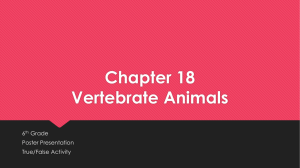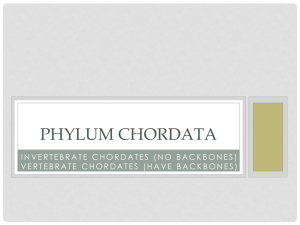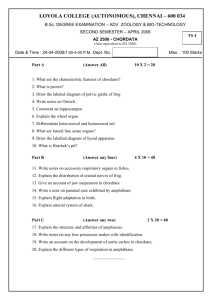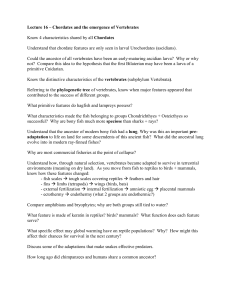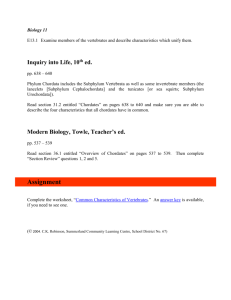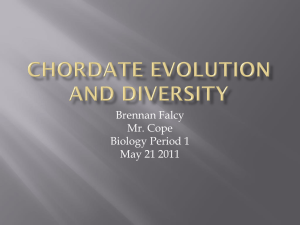Notes: Classes of Vertebrates - Mrs. Stelmaschuk's Biology 11 Class
advertisement
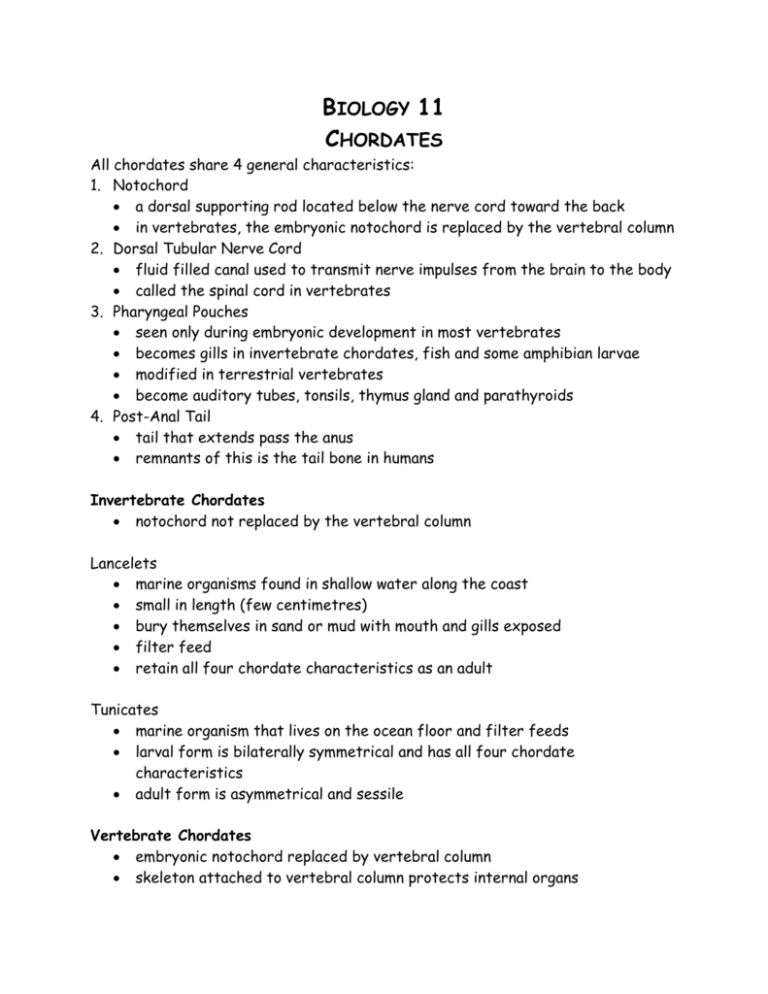
BIOLOGY 11 CHORDATES All chordates share 4 general characteristics: 1. Notochord a dorsal supporting rod located below the nerve cord toward the back in vertebrates, the embryonic notochord is replaced by the vertebral column 2. Dorsal Tubular Nerve Cord fluid filled canal used to transmit nerve impulses from the brain to the body called the spinal cord in vertebrates 3. Pharyngeal Pouches seen only during embryonic development in most vertebrates becomes gills in invertebrate chordates, fish and some amphibian larvae modified in terrestrial vertebrates become auditory tubes, tonsils, thymus gland and parathyroids 4. Post-Anal Tail tail that extends pass the anus remnants of this is the tail bone in humans Invertebrate Chordates notochord not replaced by the vertebral column Lancelets marine organisms found in shallow water along the coast small in length (few centimetres) bury themselves in sand or mud with mouth and gills exposed filter feed retain all four chordate characteristics as an adult Tunicates marine organism that lives on the ocean floor and filter feeds larval form is bilaterally symmetrical and has all four chordate characteristics adult form is asymmetrical and sessile Vertebrate Chordates embryonic notochord replaced by vertebral column skeleton attached to vertebral column protects internal organs skeleton also serves as a place for muscle attachment skull with well developed brain and attached sensory organs evolution of jaws allowed for predation to occur two pairs of appendages for rapid movement complete digestive tract, closed circulatory system kidneys make up part of excretory system and are also used for water regulation amnion allowed for terrestrial reproduction Fish Jawless Fishes (Class Agnatha) lack scales on skin no jaws no paired fins examples; hagfishes and lampreys Hagfishes are probably the most primitive vertebrates alive today. Some unique features include pinkish-grey wormlike body, they lack eyes but have light sensitive regions all over their bodies, and have a toothed tongue which they use to scape a hole into injured or dead fish. They are extremely slimey, have six hearts and possess an open circulatory system. Lampreys are filter feeders as larva and parasites as adults The adults live by using their circular sucking disks to attach themselves to fish and use their large teeth to scrape away tissue. Lampreys then suck up the tissue and body fluids of their host. Cartilaginous Fish (Class Chondrichthyes) examples are sharks, rays, skates contain an endoskeleton made of cartilage (chondros = cartilage icthys = fish) tooth-like scales covering their skin (skin often used for sand paper) sharks: large curved tails, ventral mouth, many teeth (approx. 3000 ) rays and skates: adapted for living on ocean floor, they are flattened from top to bottom and swim by flapping their large wing-like pectoral fins have specialized senses for detecting prey (sharks and rays) a. ability to sense electrical currents generated by muscle movements of other fish b. lateral line system – able to sense pressure changes in the water caused by other fish swimming nearby c. keen sense of smell – sharks can detect one drop of blood in 115 litres of water Bony fishes ( Class Osteichthyes ) oste = bone the most numerous in terms in species (about 40% of all vertebrates) examples: guppies, groupers, salmon, eels, stone fishes, scorpion fishes, trout have an endoskeleton made of bone. most are ray-finned meaning they have thin boney spines; they also have a swim bladder for buoyancy a few species are called lobed-finned fishes so named because of their fleshy type fins that can be used as walking appendages; they also have a primitive lung and are thought have evolved into amphibians. Amphibians (Class Amphibian) amphi = both; bio = life 3900 living species ( the smallest vertebrate group) examples: frogs, salamanders, newts, toads. must return to the water to breed. larva are fish-like and breath through gills, adults breath through skin and lungs their eggs are not shelled, therefore must be laid and remain in water skin does not have fur, feathers, or scales to prevent drying out lack claws 3 chambered heart – 2 atrium and one ventricle Reptiles (Class Reptilia) about 6000 species examples: snakes, lizards, tortoise, turtle, crocodile, alligators, dinosaurs have lungs, scaly skin, and amniotic eggs. the tough dry scaly skin prevents water loss but must be shed to allow the reptile to grow. efficient respiratory system Birds (Class Aves) about 8700 living species they are endothermic, have a skin covered in feathers, two legs used for walking or perching, and front limbs modified into wings without useful claws. examples: penguin, owl, blue jay, humming bird Mammals about 4500 living species all mammals share two common characteristics – presence of hair and milk producing mammary glands most are endothermic – maintain a constant internal body temperature many adaptations are related to temperature control – hair for insulation, goosebumps to raise hair and trap more air young born alive after internal fertilization and development young feed on mother’s milk for nutrition Monotremes have a cloaca like birds lay hard-shelled eggs both males and females have modified sweat glands that leak milk example: duckbill platypus, spiny anteater Marsupials born in an immature condition – crawl into pouch on mother and attach to a nipple for feeding where they finish developing example: opossum, kangaroo, koala bear Placental Mammals internal development of young by attaching to the uterus and gaining nutrients through a placenta; waste materials also pass through placenta to mother young is dependent on adults for nutrition and learning how to survive after birth all placental mammals have a well-developed brain differentiated teeth based on what they eat – herbivores, omnivores and carnivores Chordate Questions 1. Use the textbook to fill in the blanks in the evolution of chordates. 2. Name the four general characteristics that are shared by all chordates. a. _________________________________________________________ b. _________________________________________________________ c. _________________________________________________________ d. _________________________________________________________ 3. What structures do the pharyngeal pouches become in fish? _________________________________________________________ 4. What structures do the pharyngeal pouches become in humans? _________________________________________________________ 5. What is the main difference between the invertebrate chordates and the vertebrate chordates? _________________________________________________________ _________________________________________________________ _________________________________________________________ 6. An organism has all four characteristics of the chordates as an adult. Would this organism be considered higher or lower on the evolutionary scale? _________________________________________________________ 7. What three external characteristics differ between the jawless fish and the cartilaginous fish? a. _________________________________________________________ b. _________________________________________________________ c. _________________________________________________________ 8. What three adaptations do sharks have that make them more successful as a predator? a. _________________________________________________________ b. _________________________________________________________ c. _________________________________________________________ 9. What internal structure that helps with floatation do the bony ray-finned fish have that the cartilaginous fish do not have? _________________________________________________________ 10. How many chambers does a fish heart have? (Use textbook) _________________________________________________________ 11. Many adult amphibians have lungs, but they are not large enough to supply the animal with enough oxygen for survival. How do adult amphibians get the extra oxygen the need to survive? _________________________________________________________ _________________________________________________________ 12. How many chambers does an amphibian heart have? (Use textbook) _________________________________________________________ 13. How many chambers does a mammalian heart have? (Use textbook) _________________________________________________________ 14. What is the advantage of the mammalian heart design over the amphibian heart? _________________________________________________________ _________________________________________________________ _________________________________________________________ _________________________________________________________ _________________________________________________________ 15. What characteristic about birds is not shared by any other chordate? _________________________________________________________ 16. What are the two defining characteristics for mammals? a. _________________________________________________________ b. _________________________________________________________ 17. What structure do monotremes have in common with birds? _________________________________________________________ 18. What are the three purposes of the structure from question 17? a. _________________________________________________________ b. _________________________________________________________ c. _________________________________________________________ 19. What is unique about reproduction in marsupials? _________________________________________________________ _________________________________________________________ _________________________________________________________
